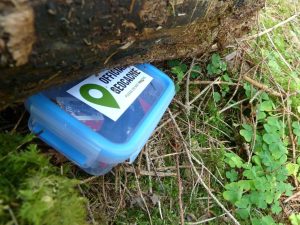
Hello and welcome to our webpage dedicated to the exciting hobby of geocaching. If you don’t know what that is, we promise you’d have a blast learning about it here. We will tell you everything about this recreational activity that has captured the attention of people all around the world.
We believe that by the end of it, you would like to participate in it like many others. We will discuss the process of geocaching and specifically how to participate and have a lot of fun while doing so. Without further ado, enjoy learning about geocaching.
What is Geocaching
Okay, before we spend the next few sections dissecting the activity that is geocaching, we should probably tell you what geocaching is.
Geocaching is a recreational activity that is done only outdoors. Participants are tasked with finding boxes (some of which contain interesting loot) by using a Global Positioning System (GPS) device, usually on their mobile phone. The coordinates of the boxes can be found in various geocaching apps. When you go to the location and find the hidden cache, you’d have to sign the log found inside.
Here’s also a quick video showing you the basics of geocaching:
Geocaching – Learn How to Do It
Let us now explain the process of geocaching in more detail than the description in the previous section.
Geocaching Apps
Let’s start with the app. In order to participate you need to download the app, but there’s not an official singular app; instead you can choose between a few, such as Geocaching by Groundspeak (available for iOS and Android), C:Geo (available for Android only), and Cachly (available for iOS only).
There are many other geocaching apps you can find at Google Play or the App Store, so the choice is yours. Some of the apps you can find are free, while others require a one-time payment (even in-app purchases). Some allow you to choose the GPS app of your choice, while others don’t.
Other differences between the apps include whether you can download the maps and use them when you’re offline. This is especially helpful if you go geocaching at a national park where the reception is almost non-existent. In addition, some apps even allow you to connect with other players, so you can help each other out.
Make sure you check the app features before you go on a hunt to ensure the conditions satisfy your specific needs.
Looking for the Cache
To go on a hunt, simply turn on your GPS, open the app, and look for the coordinates of caches in your area. When you find a location close to you that you like, follow the route using whatever mode of transportation you prefer. Once you reach it, the real fun begins.
The coordinates will only get you about 30 feet away from the cache and now it’s on you to find where it was hidden. There is only one rule when it comes to hiding the cache – it can never be underground, so there’s no need to task your dig-loving dog with finding it.
You have to be creative to find the cache, which wouldn’t be neatly placed in the middle of the road. Try to think as a detective; where would you put the cache if you wanted to really hide it? Look left, right, up, and down.
Check inside bricks or tree hollows and look for things that appear to be out of place. The possibilities are truly endless, so always try to think outside the box.
Now let’s talk about what you can actually find. Many caches are square plastic boxes of varying size, but they’re not exclusively plastic containers. The containers can be of any material and some of them are quite small (think 3-4 cm), so make sure to look around in the most virtually inaccessible spots.
However, never break property or destroy nature; the caches are not that inaccessible. Always remember to respect your surroundings.
If you’re having a hard time locating your cache, you can look on the app for hints or comments left by the people who had found it before. Still, we recommend not doing that unless absolutely necessary, because it’s part of the fun to find it all on your own.
Finding the Cache

After all your hard work, you found your cache and you feel a great sense of pride, so now what? Well, you’ll find a piece of paper or a notebook, called the logbook, that contains the logs of the people that found the cache before you.
Type in your code and name along with the date you found the cache. Remember to carry a pen or a pencil for that. Then, you can do the same in the app to reveal you found it.
Sometimes, the caches are just boxes with a logbook, but you can also find some interesting loot in there. The objects are usually of sentimental value and you’d always remember your adventure when you take one or a few out. You can leave your own little trinket in the cache-box for the next person.
The common items that you can leave in a cache are compasses, little toys (like those from Kinder eggs), coins, badges, keychains and so on. You can also write a sweet note for the next explorer!
There are now even trackable devices like geocaching trading stones or travel bugs with a unique code. You can purchase one, then type in the code in the app, which would allow you to track the adventures of your little stone or bug around the world.
You can even place a specific goal for your trackable device such as “take me to the best mountain tracks” or “take me to 10 caches in your country”. We especially like this little trinket, because it opens the door for bonus adventures.
Create a Cache
After you gain some experience on your adventures, you can leave a cache as well to create a whole new adventure for someone else. However, the procedure is not so simple and clear-cut. We will walk you through all the necessary steps:
- Read the geocache hiding guidelines. They include abiding the local laws of the location you choose to hide your cache; you might need permission from the local authorities or the private individual to whom the land belongs.
- Make sure your cache is not in close vicinity to another cache. In general, avoid to place a cache in a zone that offers an abundance of caches.
- Your cache must be accessible and it must not require any contact with a third-person to find.
- As already mentioned earlier, don’t bury the cache.
- Always include a logbook (a pencil would suffice as well).
- The cache-box should be of durable material that would sustain natural damage.
- If you place any items inside, make sure they’re suitable for all ages (no graphic content) and that they are, of course, not illegal (drugs) or dangerous (weapons).
- Think about the item’s longevity. Don’t put items that can be damaged by the weather conditions or by time itself.
- Do not promote your beliefs or your products with the contents in your cache. Geocaching is a fun game, not a platform for your ideas.
- Get an accurate GPS location, after all this is an important part of geocaching.
- Place your cache at the intended hiding spot and submit it for review.
- You should place caches in your area (close to your home) to make sure you can maintain them if it’s necessary.
- A reviewer would contact you with questions about your cache, so make sure to check your messages and respond as concisely as possible. Not all caches are approved, so don’t get upset if your first attempt is unsuccessful.
- That’s it! You’re now an official hider.
History of Geocaching
You’re probably wondering how geocaching became a thing, and we’re happy to tell you. There is an official inventor of geocaching, Dave Ulmer, who is a computer consultant hailing from Oregon. He was inspired by the improvement of GPS technology that occurred exactly on 2 May, 2000 on the direction of then-president Bill Clinton.
Ulmer wanted to see this GPS upgrade for himself, so he created “The Great American GPS Stash Hunt” only a day later on 3 May, 2000. He hid a bucket, containing items such as a software program, books, videos, and a slingshot, along with a logbook, in a forest near Beavercreek, Oregon. He shared the coordinates in an Internet group dedicated to the GPS technology.
He also encouraged other people to follow his example and hide items of their own, as well as to leave items in the original bucket. Only three days later, Mike Teague found Ulmer’s bucket and proved that the new GPS technology was indeed reliable. Teague shared his experience online, which inspired other people to create cashes.
Teague decided to publish the coordinates of each new cache on his personal blog to create a community of hiders and seekers around the world. An email list was also created and sent to the enthusiasts.
The name “geocaching” was coined by Matt Stum a few weeks later to describe the fun GPS treasure hunt. “Geo” means Earth and it shows that this recreational activity is an international one, while “cashing” describes the process of using a temporary hiding place to stash items.
Back then, geocaching wasn’t that simple. The first seekers were people who already had experience with GPS technology, but even then, the process took much longer than nowadays when you have a smartphone with sophisticated GPS and tons of clues in special geocaching apps. The hobby has truly come a long way.
Types of Caches

Although the most typical type of cache is a box containing a logbook and some items, the game has actually evolved quite a lot for its 22 years and it now includes many different types of caches as imagined by enthusiastic explorers. Here they are:
- Traditional cache – you have the coordinates of the cache that is comprised of a box containing a logbook and perhaps items.
- Multi-cache – you have the coordinates of the first clue leading to your cache. When you find it, you might be taken to another location where the actual cache is or a few more locations containing clues to finding it.
- Mystery cache – you have the coordinates of a puzzle that you need to solve, which would reveal the coordinates of a physical cache.
- Letterbox hybrid cache – letterboxing is another type of treasure hunt similar to geocaching, but it relies on clues rather than coordinates to locate the hidden box. The letterbox hybrid cache combines letterboxing with geocaching, so there are clues, as well as coordinates that would lead you to the coveted box.
- EarthCache – you get the coordinates of a specific location that would teach you more about the geology of the area, as well as scientific facts about the place. There is no physical box to find, so to log your finding, you’d need to respond to questions online.
- Virtual Cache – similar to the EarthCache, the virtual cache doesn’t have a physical box to find, so again you’d have to respond to questions or post a picture online to create a new log. Virtual caches, however, are no longer created, but the existing ones remain active.
- Webcam Cache – you’d get the coordinates of a location that is being monitored by webcams. The goal is to be seen on the webcam and to take a screenshot using the webcam’s website in order to post a log.
- Event Cache – this type of cache involves a gathering of a group of geocachers. The event is publicized and everyone gets the coordinates at the same time.
- Mega-Event Cache – the idea is similar to that of the event cache, but the event itself lasts longer and has more participants (500+).
- Giga-Event Cache – same as the mega-event cache, but the participants are more than 5000 and there would certainly be more events (apart from the geocaching itself).
- Wherigo Cache – this type of cache takes you on a long adventure with your trusted GPS where you would encounter real-world or virtual places and characters. In order to participate, you need to use Wherigo. Make sure to carefully read the instructions, because the process requires a few steps to set up.
- Cache in Trash Out Event – what’s better than hunting caches, while cleaning up our hiding spots? This event asks for a group of geocachers to pick up litter in a bit to preserve the nature we love exploring together.
Depending on how many of these caches you find (both the number of all caches you find and the number of each type of cache, e.g. finding 10 EarthCaches), you might receive prizes that would show everyone that you’re a master seeker. It’s yet another feature to get more people involved in the exciting hobby.
The Best Geocaching Locations
Geocaching is a great way to explore a new area and learn about it while you’re playing the game. This is why we highly recommend you go geocaching in place you’ve never been before, so you can get a sense of its beauty.
This is why we decided to dedicate the last section of our article to the most picturesque places with geocaches, as well as those that have a lot of geocaches in one place. Plan your next trip by checking out the areas with the highest concentration of caches or the ones that offer the most breathtaking views.
- Bighorn National Forest, Wyoming – we recommend you visit this gorgeous forest even if you don’t go geocaching, but this hunt would actually take you to some of the secluded and picturesque locations of the forest.
- Las Vegas, Nevada – if you want to find geocaches at every street corner, Las Vegas is the place, baby! However, keep in mind there are a lot of muggles (people who don’t go geocaching, but find the boxes and also damage them sometimes).
- San Francisco, California – another big city filled with geocaches. We hear though that these are some of the hardest to find, so if you like a challenge, go there!
- Grand Junction, Colorado – the iconic red rocks hide many lovely geocaches that are waiting for you.
- Petrified Forest National Park, Arizona – take in the alien beauty of the rocks and the trees as you’re looking for your coveted caches.
- North of Glasgow, Scotland – find the first Scottish geocache by setting your GPS to OS (Ordnance Survey). Keep in mind that cache is very hard to find.
- Bray, Ireland – take in the beauty of the Emerald Ireland by finding Europe’s oldest geocache.
- Deception Island, Antarctica – if you ever find yourself on the seventh continent, take a trip to Deception Island and find the hidden cache.
- Mount Fuji, Japan – Japan’s highest mountain offers the arguably best view to geocachers.
- Cape Town, South Africa – the South African geocaching community continues adding more and more caches for you to find.
- Lago Chungara, Chile – another breath-taking scenery to enjoy while looking for the 4-rated geocache.
